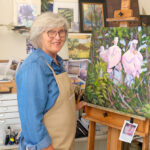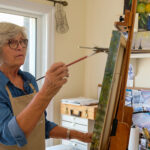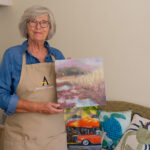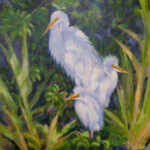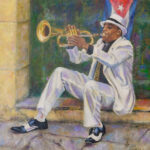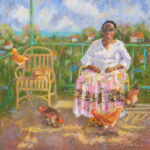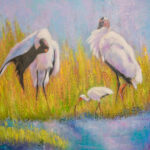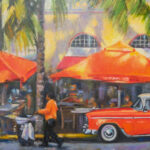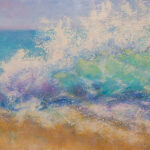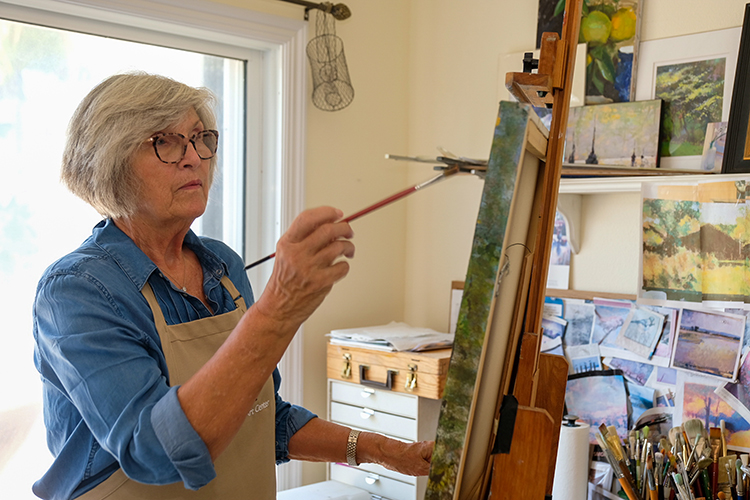
A beach cabana generally conjures up visions of a small space with maybe a bench, hooks for towels and a small door, and may seem like an unlikely spot for an artist’s studio.
However, Muci Clemens happened on the perfect setting for her cabana art studio, incorporated into the Orchid Island Beach Club.
An aesthetic gem, this air-conditioned beach cabana features a charming room with a mini kitchen, a wall of windows giving a look at the ocean and a balcony. Here, inspiration flows by osmosis, just walking through the complex.
Clemens, who is right at home, creating wonderful paintings that are true to her core beliefs, calls it “a magical, special place.”
Although taught to paint traditionally, she says, “I put emphasis on what is important to me, what really matters, instead of just painting a pretty picture.”
From still life to landscapes and portraits, Clemens paints in a representational, impressionistic style, primarily working in oils and pastels. She explains that her work is influenced by the rebirth of nature, the dependable cycle of life, peaceful and pensive, filled with light and a colorful palette.
Growing up in Montclair, N.J., she recalls picking up a matchbook at age 8, the cover of which advertised an art school with drawings of a dog and a cat. Clemens copied the dog on paper, impressing her parents, who encouraged her to work on her art.
“It was all part of my family; to encourage the arts. My father loved to paint, and I had an uncle who was an artist.”
While in high school, she practiced her art during the week and took the bus to Manhattan on Saturdays to take drawing courses at the Art Students League. On the way home she would stop and visit museums, especially the Metropolitan Museum of Art.
There she studied, again and again, the large-scale (“it must have been 10 feet by 10 feet”) painting called “The Tree of Life” by Cy Twombly.
“Each time you looked at it there was more and more. The artist must have spent half his life painting that painting. It was incredibly quizzical. I learned that maybe you don’t have to spell everything out, but get the viewer engaged, like that artist did for me.”
Fortuitously, her family was invited to go to Rhode Island, where one of their friend’s neighbors was Cy Twombly.
“My mother’s friend let him know I was interested in art, and he invited me to visit his studio and show me his paintings and to talk about art. I was so excited. It was the first time I realized artists could actually support themselves by creating art,” says Clemens.
“Most people don’t get to that point because life gets in the way. And you can have a string of sales, but then if you change your style, you lose that whole audience, or they get upset with you. I used to do still life, and I really worked to get all of those hairs on those peaches. But as an artist, I want to change, I want to improve my craft.”
So she made a change to focus on other subjects, including animals, landscapes and people.
“It’s exciting and it’s magical to keep improving and to keep changing,” says Clemens, adding that after making the switch, she had collectors who were upset with the change.
“What happens is, when you have an audience of people who like your work, they expect you to keep doing the same, so they can see what your ‘new still life’ paintings are.”
After studying at Rosemont College, Clemens earned a degree in art and applied art at San Diego State University and has been fortunate to participate in workshops with numerous renowned artists. Clemens also took classes at Silvermine Arts Center in New Canaan, Conn., from Russian artist Kirill Doron.
“He taught me details, which I really needed. In Russia, he was one of those who would have spent a year painting all the details of an orange. But in all my art schooling they didn’t teach me the details,” Clemens explains.
“They never taught you how to use a paint brush, or how to mix paints. So in those things I felt inept.”
Although she does believe you can get stifled by over-education, she explains, “It’s a dance, a thought process. You’re solving problems constantly. You end up knowing what works for you and what doesn’t, what rules you can break this time or which you should stick to. So it’s really good.”
She added encaustic, aka hot wax painting, to her repertoire in the last four to five years.
“In encaustic work, you get much more involved with the painting you have destroyed by sanding [layers of wax]. And you have to rebuild it. It’s a process. There are some paintings that take so long, [it’s] best to put it off to the side for a while instead of forcing yourself to finish it,” she explains.
“You need to be exposed to different thought processes. You improve with the tools you have. Everything is a learning process and you keep moving forward.”
Clemens says that if she goes to sleep with a design problem, she usually wakes up with several solutions.
“There is a level of excitement that you can finally create.”
In one workshop, Clemens learned about grids – how to make the painting stronger by naturally dividing it into areas.
“I’m utilizing things that have been known for thousands of years, but I was never taught that in school. The grid gives a painting a more powerful composition. Now that I understand it, I am utilizing it in my work.”
Although she enjoys selling her work, Clemens also enjoys gifting it. “It makes me so satisfied to give someone a special gift. It’s karma; it’s important to give back. It gives me a gift back. It makes me feel proud that I can do that.”
In one instance, she created a beautiful painting of a dear friend who had passed away and gave it to her friend’s daughter as a wedding present. That painting will be treasured forever.
“Expressing yourself is a need; finding a creative outlet is therapy, fulfillment,” says Clemens.
To counter the immense pain in the world, she consciously chooses light, color and uplifting themes to focus on the positive, timeless quality of life.
“I create works that make me feel good: the stillness of the day, ripening fruit, the breathtaking beauty of flowers, time by the water, the character of a person’s face, life that lights up one’s eyes,” says Clemens, noting that through her art, she can share joy.
“Art is like an athlete – you have to practice it a lot. You don’t just get up one day and paint a good picture, to pass on to the viewer the feeling you are trying to create, this magical thing you want to paint.”
Clemens is a member of the Vero Beach Art Club, Connecticut Pastel Society, Pastel Society of America, Oil Painters of America, and the Orchid Island Art Club, which has a robust membership and a yearly art show. She holds elected artist status in Audubon Artists and, in Connecticut, the Madison Art Society and Guilford Art League.
Photos by Joshua Kodis

